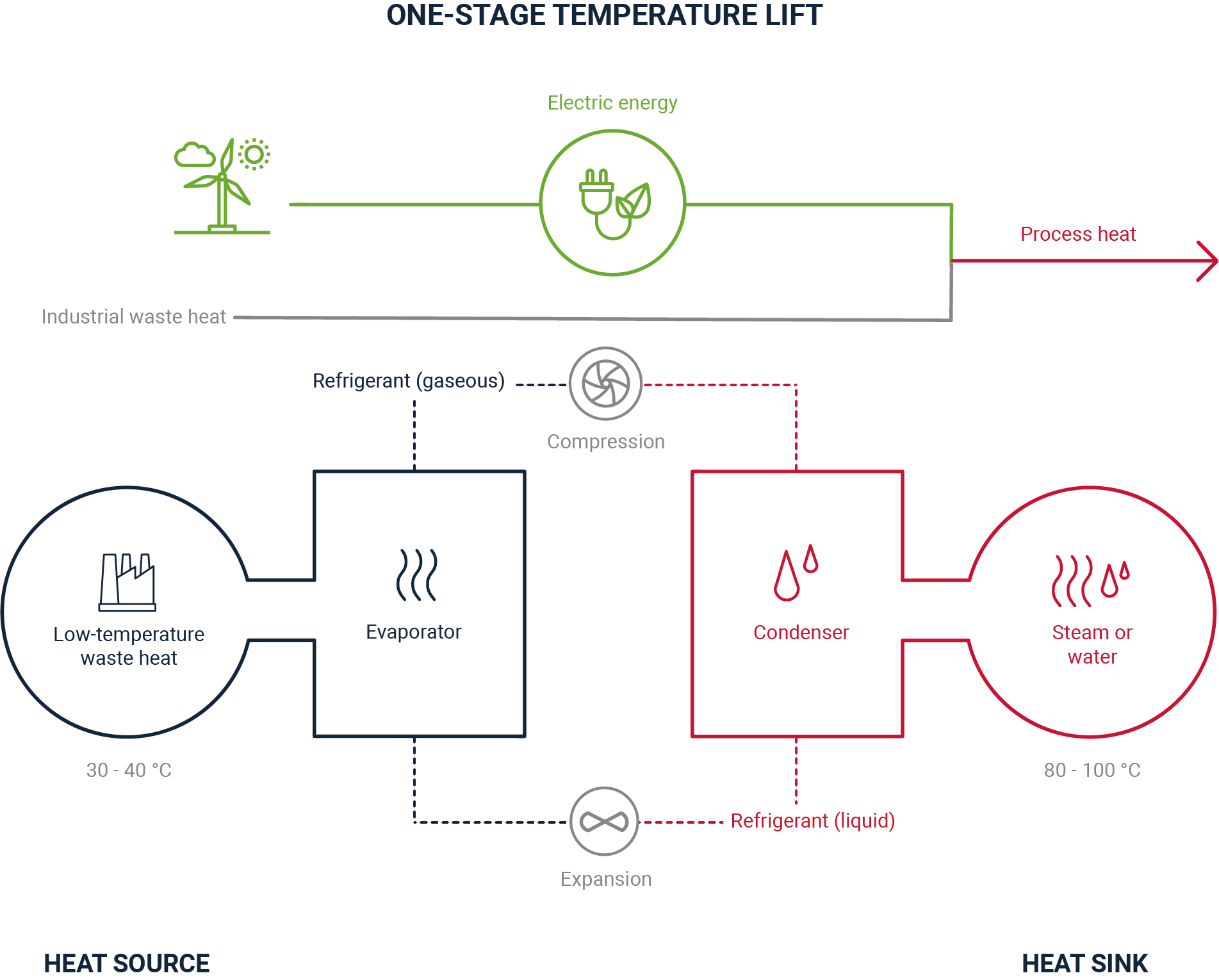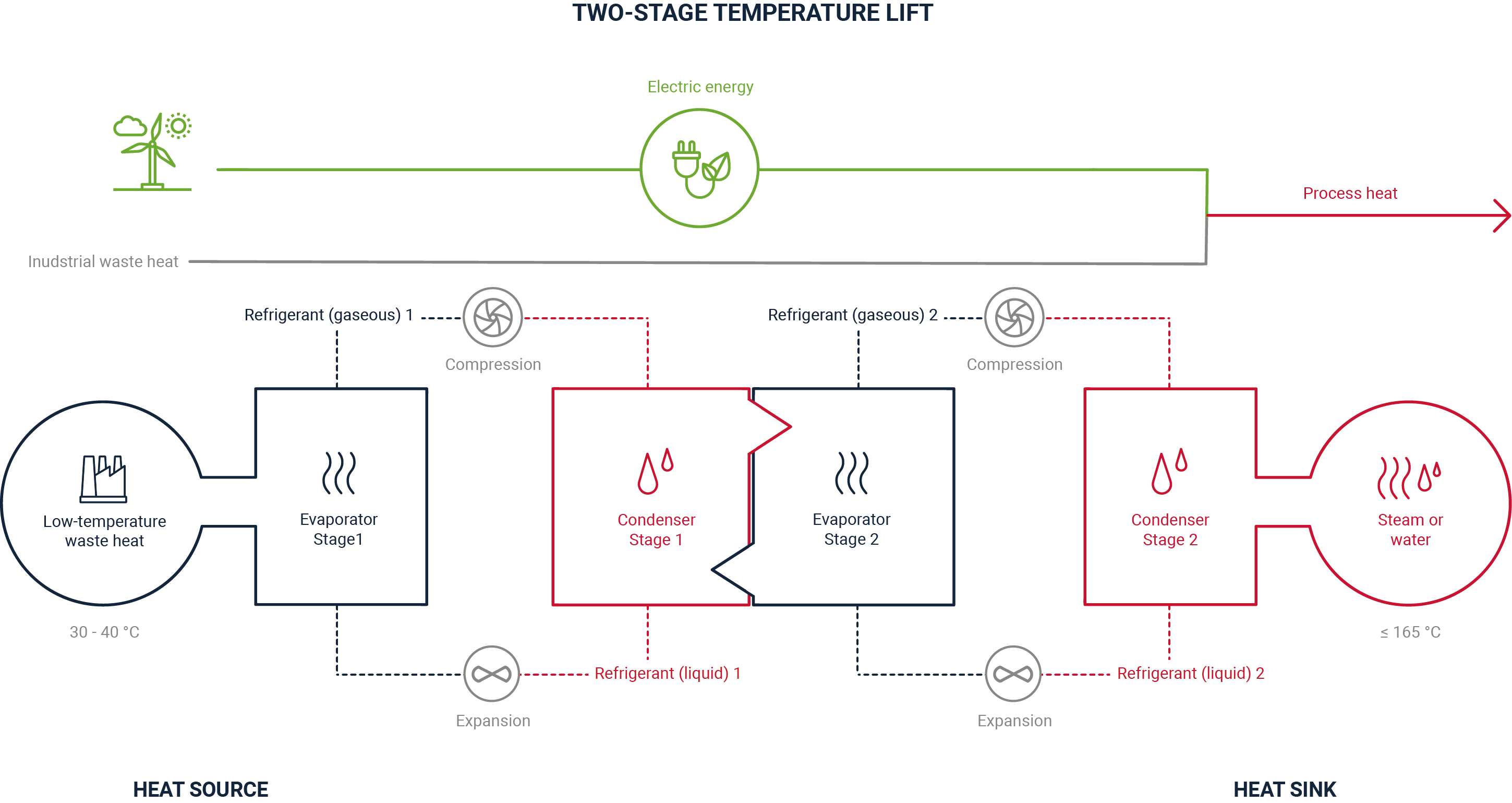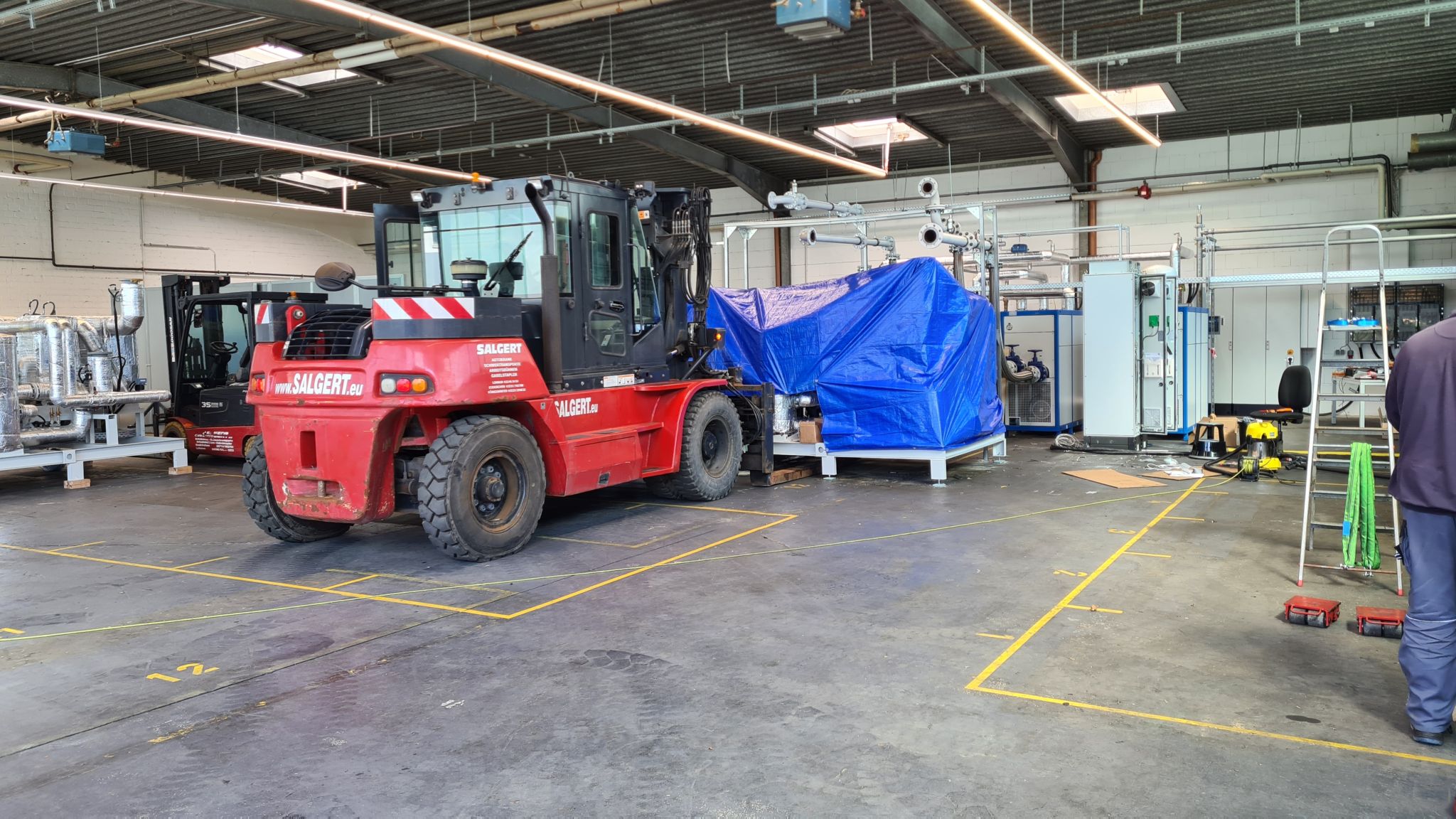Overcoming limits: Two-stage temperature lift for high-temperature heat pumps
A two-stage temperature lift in high-temperature heat pumps bridges large temperature differences and thus ensures that even low-temperature waste heat can be brought to the high process temperatures that are often required in the food, textile or pharmaceutical industries from around 30-40 °C. We explain exactly how this works in this article.
Efficient heat from environmental energy
Functional principle of heat pumps
In simple terms, heat pumps extract heat at low temperatures from their surroundings and use electricity to generate higher temperatures. Conventional heat pumps for use in single-family homes, district heating networks or industry utilise thermal environmental energy, electrical energy and refrigerants to achieve the desired temperatures.
To do this, they extract heat energy from the heat source used – for example, the ambient air. This takes place in a closed cycle by constantly changing the aggregate state of the refrigerant used (evaporation, compression, condensation, expansion, vaporisation...). Heat pumps then transfer the generated heat to a heat sink, for example to a hot water circuit. The process can be divided into four steps:
- Heat absorption
Refrigerant flows through the so-called evaporator in liquid form. This is located in a place where heat can be absorbed from the environment (air, water or ground). The refrigerant absorbs this heat and vaporises. - Compression
The now gaseous refrigerant is channelled through the system and compressed by a compressor. This significantly increases the temperature of the refrigerant. - Heat dissipation
The hot, gaseous refrigerant is transferred to a condenser. Here, the refrigerant transfers its heat to the heat sink via a heat exchanger. This causes the refrigerant to cool down and become liquid again. - Expansion
The refrigerant, which is now liquid again, flows through an expansion valve, which reduces the pressure again. This pressure reduction cools the refrigerant further and allows it to absorb new heat.

This operating principle also applies to high-temperature heat pumps for industrial use. Here, however, a temperature increase in two stages is often used – the so-called two-stage temperature lift.
The role of heat source and heat sink
Before we delve into the intricacies of the two-stage temperature increase in high-temperature heat pumps, we should first familiarise ourselves with and understand the basic components of heat pump systems: The heat source and the heat sink.
- In a heat pump, the heat source supplies the thermal energy for the system. In the case of heat pumps for heating buildings, for example, these heat sources can be the ambient air or the ground. In industrial applications, it is usually the residual and process heat from industrial processes, as is the case with our ThermBooster™.
- The heat sink is the point at which the generated heat is transferred to its 'destination'. The efficiency and effectiveness of a high-temperature heat pump system depends heavily on the properties of both the heat source and the heat sink.
Overcoming the temperature differences between the heat source and the heat sink is known as the temperature lift. In single-stage heat pumps, due to their design this temperature lift is only possible within a certain range – here usually a temperature difference of around 60 degrees Celsius can be bridged.
Did you know:
Kelvin or Degrees Celsius
In science and technology, the temperature difference (or temperature delta) is usually expressed in Kelvin (K). However, the difference between two temperature values in Kelvin and degrees Celsius (°C) is numerically the same. A temperature difference of 60 Kelvin therefore equals a temperature difference of 60 degrees Celsius.
Two-stage heat pumps overcome the previous limitations
It is often wrongly assumed that the limitations of single-stage heat pumps cannot be overcome without the COP (coefficient of performance) being unfavourable. This is precisely why low-temperature waste heat with temperatures of 30 to 40 degrees Celsius is often no longer used: It is assumed that it can only be heated to around 90 to 100 degrees Celsius in single-stage heat pumps – too little for most industrial processes. This actually valuable waste heat, which is generated during many manufacturing, processing and refining processes, is often wasted instead. However, it can still be utilised sensibly and efficiently.
To achieve this, however, industrial heat pumps need to enable a larger temperature lift in order to bring low-temperature residual heat from very low temperature ranges of around 30 to 40 degrees Celsius to temperatures of around 160 to 165 degrees Celsius, as required for many industrial processes. This is where the ThermBooster™ with its two-stage temperature range comes in.
Did you know:
Efficiency and COP
There is a difference between efficiency and the COP (Coefficient of Performance): Efficiency describes the ratio between the energy supplied and the work performed. So if a system takes in 100 units of energy (e.g. electricity) and produces 70 units of work, the efficiency is 0.7 or 70 per cent. The COP describes the ratio between the energy input and the heat or cold output. Unlike efficiency, the COP of a heat pump can be greater than 1 or 100 per cent, as heat pumps use ambient heat. For example, a high-temperature heat pump can achieve a COP of 2.5 and higher.
The two-stage temperature lift: this is how it works
In conventional heat pump systems, a single compression cycle is used to raise the temperature of the refrigerant from the heat source to the desired output temperature at the heat sink. The design limitations of the compressor in combination with the properties of the refrigerant used, limit the maximum temperature lift that can be achieved.
To overcome this limitation, high-temperature heat pumps often utilise a two-stage, cascaded heat pump process to enable a higher temperature lift. In this approach, there are two refrigerant circuits and two compressors. The refrigerants used in these two circuits differ from each other and are each optimised for the temperatures and pressures prevailing in the circuits. In this system, the condenser of the first circuit also serves as the evaporator of the second circuit. This way, compressors, valves and refrigerants can be optimized for the very different system requirements. This is the prerequisite for safe, reliable and efficient operation.
Did you know:
Optimized refrigerants
Refrigerants differ from each other in terms of their thermodynamic properties. This makes certain refrigerants particularly suitable for certain temperature ranges. The differences lie primarily – but not exclusively – in their evaporation curve, i.e. the temperature at which a refrigerant evaporates at a certain pressure.
By splitting the system into two coordinated circuits, the heat pump can achieve higher output temperatures and therefore a significantly greater temperature lift than with just one refrigerant circuit.

The advantages of the two-stage temperature lift
The use of two-stage temperature lifts in high-temperature heat pumps offers crucial advantages:
- Extended temperature range: The two-stage temperature lift makes it possible to achieve higher output temperatures than with single-stage compression. This extended temperature range increases the versatility of the heat pump and opens up new areas of application: Waste heat with temperatures of just 30 to 40 degrees Celsius can be heated to the required temperatures of over 160 degrees Celsius and utilised effectively.
- Improved performance: The optimised compression process in both stages ensures improved performance and reliability of the entire heat pump system. This results in improved process control, productivity and better overall operating efficiency for industrial applications.
Possible areas of application for two-stage high-temperature heat pumps
The two-stage temperature lift therefore offers particular advantages in scenarios in which the required temperature lift or the required output temperature exceeds the possibilities of single-stage compression. This is typically the case when the desired temperature lift is above 60 degrees Celsius.
Application example from SPH practice
As part of the EU-funded Push2Heat project, SPH recently supplied the high-temperature heat pump ThermBooster™ with two-stage temperature lift to the paper manufacturer Felix Schoeller.
The Felix Schoeller company generates low-pressure steam at a pressure of around 2 bar(a), which is used to dry the produced paper. Heat is recovered from the paper machine at around 45 degrees Celsius, which would normally be lost. This heat is used to operate the ThermBooster™. Due to the relatively high temperature lift required in the next step, our high-temperature heat pump operates in two stages.
The ThermBooster™ is housed in containers and will save Felix Schoeller considerable amounts of CO2 emissions and unnecessary energy costs every year.

The two-stage temperature lift in high-temperature heat pumps opens up new areas of application
In summary, it can therefore be said that the two-stage temperature lift is an important solution for high-temperature heat pumps, enabling them to achieve a significantly greater temperature lift and higher output temperatures.
By splitting the temperature lift into two stages, innovative heat pump systems such as the ThermBooster™ can fulfil the demanding thermal requirements of various industrial processes effectively and in an environmentally friendly manner – even if the waste heat used only has temperatures of 30 to 40 degrees Celsius.
By the way:
If you would like to find out more about the use of high-temperature heat pumps to provide process vapour, we will be happy to assist you – we have dedicated a separate article to this topic:

